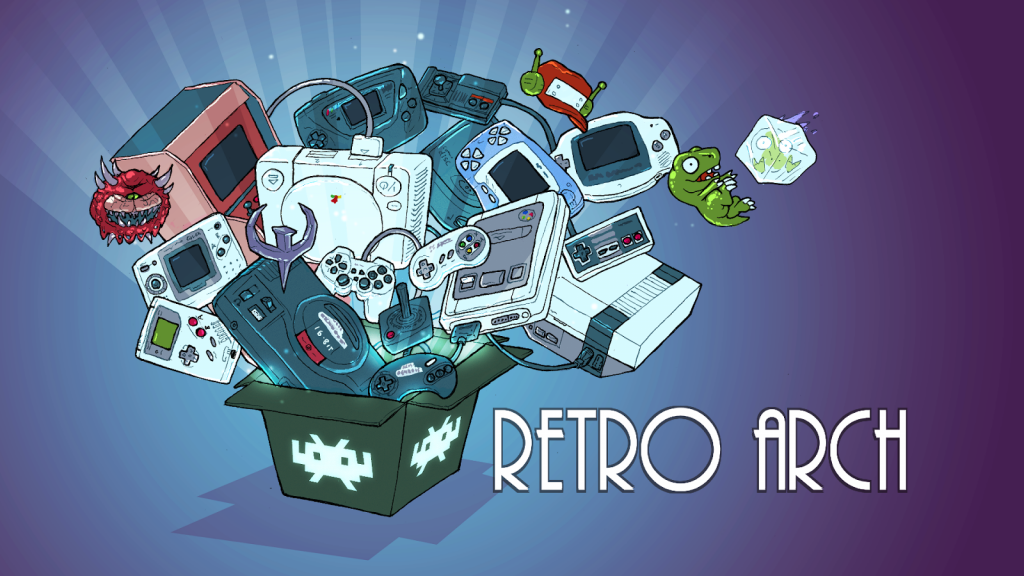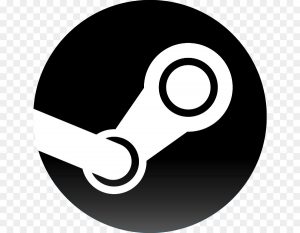
RetroArch 1.9.10 has just been released.
Grab it here.
If you’d like to learn more about upcoming releases, please consult our roadmap here. The next version of Lakka (with an updated RetroArch 1.9.10 version) is scheduled to be released very soon!
Remember that this project exists for the benefit of our users, and that we wouldn’t keep doing this were it not for spreading the love to our users. This project exists because of your support and belief in us to keep going doing great things. If you’d like to show your support, consider donating to us. Check here in order to learn more. In addition to being able to support us on Patreon, there is now also the option to sponsor us on Github Sponsors! You can also help us out by buying some of our merch on our Teespring store!
Highlights

RetroArch is now finally on Steam!
On September 14, 2021, RetroArch finally appeared on Steam (available here). It is available right now for both Linux (SteamOS) and Windows. See our initial release article here. Since then, we have already had over 100K+ downloads on Steam and over one million visits. Thanks to you all! We aim to make RetroArch the very best it can be.
What you need to know:
- New cores are coming as DLC additions.
- There is no macOS version available on Steam yet (but we’d like to!)
- Remote Play is supported. We make no guarantees as to how well this will work.
- Steam Cloud sync should be supported for save files.
- There is work underway on automation – the idea is that both cores and RetroArch on Steam would be updated automatically.
Lastly, we hope that new users can be understanding of the fact that RetroArch’s UI might have a bit of an initial learning curve. We are a small team, and we definitely intend to simplify the UI at least for beginners in the coming months, but we are simply not ready yet. So we hope people are understanding of this and appreciate the swiss knife flexibility and power of RetroArch in the meantime instead of focusing on the overall complexities or whatnot of the UI/UX.
The Steam version should be updated to 1.9.10 soon.
High Dynamic Range fixes for D3D11/D3D12!
- Fixed contrast to be more correct – now scales from 0-10 linearly and behaves more the way you’d expect it to – changed name to ditch legacy settings users may have
- D3D11/HDR: Fixed D3D11’s blend, rasterizer and topology states not being set to the sames when using HDR and leaving the menu – caused issues with PCSX2’s Shadow of the Colossus
- Added ability to skip inverse tonemapper to the shader via the constant buffer using ‘inverse_tonemap’ – set to 0.0f to skip
- Fixed potential bug when swapping between HDR and SDR and the bit depth not being set correctly
Filters
1.9.10 adds a new Picoscale_256x-320×240 video filter. This uses a number of high quality, high performance algorithms developed by irixxxx for Picodrive standalone to upscale 256×224, 256×239 and 256×240 content to 320×240 (content of any other resolution is passed through unchanged).
Much like the existing Upscale_256x-320×240 filter, this is intended for use on platforms/devices with native 320×240 resolution support, where it greatly reduces aliasing while producing a significantly sharper image than conventional (hardware) bilinear filtering.
Three filter variants are provided:
Picoscale_snn_256x-320×240: ‘Smoothed’ nearest neighbour
Picoscale_bl2_256x-320×240: 2-level-bilinear with 2 quantized weights
Picoscale_bl4_256x-320×240: 4-level-bilinear with 4 quantized weights
Essentially, both image ‘smoothness’ and performance requirements increase in order of snn -> bl2 -> bl4.
Go here to see several screenshots demonstrating the output of each filter type: (click for full-size images)
These filters are highly efficient. Tested with the Snes9x 2005 Plus core (a lightweight core which is nonetheless at the upper limit of many low powered handheld devices), we see the following increase in total performance overheads when each filter is applied (note that the existing Upscale_256x-320×240 filter is included for comparison):
| Filter |
Performance overhead |
| No filter |
+0% |
| snn |
+8% |
bl2 |
+13% |
| bl4 |
+30% |
| upscale_256x_320x240 |
+27% |
The performance overheads relative to the existing Upscale_256x-320×240 filter are:
| Filter |
Performance overhead |
| snn |
-69% |
| bl2 |
-45% |
| bl4 |
+14% |
Thus SNN and BL2 in particular have very little performance impact.
All credit goes to irixxxx – many thanks for giving us permission to use your work in RetroArch!
In other video filter news, the Switch/libnx port now also has video filters support!
Playlist Manager – New ‘Refresh Playlist’ option
The manual content scanner provides a quick and easy method for generating playlists – but there exists no convenient way to update playlists that already exist. If a user adds content to a ROM directory then they must go to the trouble of reconfiguring and re-running the manual scan (including selecting the ROM directory, system name, default core, etc.); if they have simultaneously removed some files, then they are also obliged to go to the relevant ‘playlist manager’ menu and ‘clean’ the playlist. This is time consuming and tedious.
1.9.10 adds a new Refresh Playlist option to the ‘playlist manager’ menus. When selected, the current playlist will be re-scanned with the manual scan configuration that was last used to generate/edit the playlist. ‘Refreshing’ a playlist also populates all entries of the Manual Scan menu – so it is easy to tweak values should the user wish to update the allowed file extension list, etc..
In addition: a new Validate Existing Entries option has been added to the manual scan interface. When enabled, any existing playlist is checked before commencing the content scan; entries referring to missing files, or files with invalid extensions, are then removed.
Validate Existing Entries is disabled by default, but automatically enabled whenever a playlist is refreshed. Thus selecting Refresh Playlist will both add new content and remove missing/invalid entries.
Note:
- This functionality will not work with playlists generated before this commit, since they will lack the required metadata. It will be necessary for the user to re-run a ‘normal’ manual scan for any playlist they might want to later refresh; thereafter, the Refresh Playlist option will appear in the relevant ‘playlist manager’ menu and maintenance becomes a one-button affair.
- We can only ‘refresh’ playlists created via the manual content scanner – not the database scanner. When performing a database scan, there is no practical method for extracting all required metadata for a repeat operation.
3DS – Add bottom screen idle state
Some nice QoL improvement for RetroArch 3DS users! 1.9.10 allows the bottom screen on the 3DS to be disabled when idle. On compatible devices, the bottom screen backlight is toggled.
If no core is running, the bottom screen is always idle with the backlight turned off.
If a core is running with the bottom screen in it’s ‘default state’, the bottom screen will idle in ~6 seconds. The displayed text “Tap the bottom screen to go to the Retroarch menu” fades out and the LCD backlight is disabled.
When interacted with the screen, the backlight turns on and toggles the menu as usual.
When in the menu / paused, the bottom screen remains active.
RetroAchievements/Cheevos improvements
Don’t write achievement credentials to override
Ignores changes to cheevos_token, cheevos_password, and cheevos_username when generating config override files.
While this is particularly important for not remembering a stale authentication token, not entering any credentials until after loading content, and then saving the override could lead to the actual password being stored in the override even after the authentication token is generated and put in the master settings file.
Since neither the authentication token nor the password should be stored in the override file, I believe it also makes sense to exclude the username, as having a per-override username would also require a per-override authentication token or password. If a players wants to have a separate retroachievements user for a specific core, they can still manually add the entries to the override file, but those will be cleared out any time they update the override file from within the application. A better solution would be to use separate master configs and launch using the –config option.
Disable slowmotion when enabling hardcore mode
There’s already code preventing the user from toggling (or otherwise using) slowmotion when achievement hardcore mode is enabled. Slowmotion provides an advantage for the user’s reflexes, so we don’t allow it in hardcore mode.
This addresses an issue where the user could enable hardcore mode with slowmotion already toggled on, and it would remain on. The user would be locked in slowmotion as the toggle would be disabled, but with enough patience, it could be worth it. With this change, slowmotion is disabled when enabling hardcore mode.
Changelog
1.9.10
- 3DS: Add bottom screen idle state
- 3DS: Add unique IDs for Gearboy/Gearcoleco/Gearsystem, correct CAP32 code
- 3DS/SAVESTATES: Fix RAM states to file when core deinits
- AUDIO/MIXER: Pad sample buffers to prevent potential heap-buffer-overflows when resampling (fixes crash when using 30 kHz menu audio files)
- AUDIO/LINUX/SNAP: Add JACK support
- CHEEVOS: Don’t write achievement credentials to overrides
- CHEEVOS: Disable slowmotion when enabling hardcore mode
- D3D9: Fixed MVP matrix issue for RGUI texture (main game frame still won’t show up though)
- D3D11/D3D12/HDR: Fixed contrast to be more correct – now scales from 0-10 linearly and behaves more the way you’d expect it to – changed name to ditch legacy settings users may have
- D3D11/HDR: Fixed D3D11’s blend, rasterizer and topology states not being set to the sames when using HDR and leaving the menu – caused issues with PCSX2’s Shadow of the Colossus
- D3D11/D3D12/HDR: Added ability to skip inverse tonemapper to the shader via the constant buffer using ‘inverse_tonemap’ – set to 0.0f to skip
- D3D11/D3D12/HDR: Fixed potential bug when swapping between hdr and sdr and the bit depth not being set correctly
- D3D11/D3D12/HDR: Added numerous helper functions to help create the correct values to colour the UI – normally the white UI elements should be rendered at paper white not max brightness for various reasons
- BUGFIX/ANDROID: Fix crash that could happen on Android with Sameboy core – would crash on rumble function
- GFX/WIDGETS: New regular widget message appearance
- INPUT/MOUSE: Add distinct mouse zero index label for drivers that do not support multimouse
- INPUT/RUMBLE: Add generic rumble gain to input settings
- INPUT/UDEV/X11: Add workaround to fix keyboard input when using X11 + Udev
- LIBNX/SWITCH: Add Video Filters support
- LOCALIZATION: Fetch translations from Crowdin
- OPENDINGUX/BETA: Disable OpenAL
- PLAYLISTS: Add ‘Refresh Playlist’ option
- STEAM: Initial release on Steam
- UWP/VFS/XBOX: Improvements and bugfixes to UWP VFS driver
- VIDEO/REFRESH RATE: Automatic PAL/NTSC refresh rate switch where available – as long as the platform display server allows changing refresh rates and the display has the desired refresh rate
- VIDEO FILTERS: Add ‘Picoscale_256x-320×240’ video filter
- WIIU/HID: Fix analog inputs on HID devices



